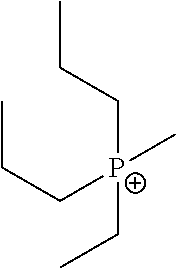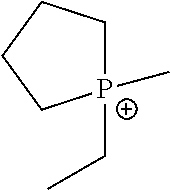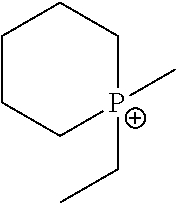Methods Of Enhancing Electrochemical Double Layer Capacitor (EDLC) Performance And EDLC Devices Formed Therefrom
a double-layer capacitor and electrochemical technology, applied in the direction of capacitors, supercapacitors or ultracapacitors, transportation and packaging, etc., can solve the problems of operating voltage shortening the lifetime of edlc, and the cycle life of edlc far exceeding that of battery systems, so as to enhance the performance and enhance the operation. , the effect of enhancing the performan
- Summary
- Abstract
- Description
- Claims
- Application Information
AI Technical Summary
Benefits of technology
Problems solved by technology
Method used
Image
Examples
example 1
[0241]Phosphonium ionic liquids were prepared. AgSO3CF3 was charged into a 50 ml round bottom (Rb) flask and assembled to a 3 cm swivel frit. The flask was evacuated and brought into a glove box. In the glove box, di-n-proply ethyl methyl phosphonium iodide was added and the flask re-assembled, brought to the vacuum line, evacuated, and ahydrous THF was vacuum transferred in. The flask was allowed to warm to room temperature and was then heated to 40° C. for 2 hours. This resulted in the formation of a light green bead-like solid.
[0242]This solid was removed by filtration. This yielded a pearly, opalescent solution. Volatile materials were removed under high vacuum with heating using a 30° C. hot water bath. This resulted in a white crystalline material with a yield of 0.470 g. Thermogravimetric Analysis (TGA) was performed on the material and the results are shown in FIG. 7.
example 2
[0243]Further phosphonium ionic liquids were prepared. Di-n-propyl ethyl methyl phosphonium iodide was added to a 100 ml Rb flask in a glove box, then removed and dissolved in 50 ml of DI H2O. To this solution, AgO2CCF3 was added, immediately yielding a yellow, bead-like precipitate. After stirring for 2 hours, AgI was removed by filtration and the cake was washed 3 times with 5 ml each of DI H2O. The bulk water was removed on the rotary evaporator. This yielded a clear, low viscosity liquid which was then dried under high vacuum with heating and stirring. This resulted in solidification of the material. Gentle warming of the white solid in a warm water bath resulted in a liquid which appeared to melt just above room temperature. This experiment yielded 0.410 g of material. The reaction scheme is depicted in FIG. 8A. Thermogravimetric Analysis (TGA) and evolved gas analysis (EGA) tests were performed on the material and the results are shown in FIG. 8B and FIG. 8C, respectively.
example 3
[0244]In this example, di-n-propyl ethyl methyl phosphonium iodide was added to a 100 ml Rb flask in a glove box, and then brought out of the fume hood and dissolved in 70 ml MeOH. Next, AgO2CCF2CF2CF3 was added, immediately giving a yellow colored slurry. After stirring for 3 hours the solids were moved by filtration, the bulk MeOH removed by rotary evaporation and the remaining residue dried under high vacuum. This gave a yellow, gel-like slushy material. “Liquid” type crystals were observed forming on the sides of the Rb flask, when then “melted” away upon scraping of the flask. This experiment yielded 0.618 g of material. Thermogravimetric Analysis (TGA) was performed on the material and the results are shown in FIG. 9A. Evolved Gas Analysis (EGA) was also performed and the results are shown in FIG. 9B.
PUM
 Login to View More
Login to View More Abstract
Description
Claims
Application Information
 Login to View More
Login to View More - R&D
- Intellectual Property
- Life Sciences
- Materials
- Tech Scout
- Unparalleled Data Quality
- Higher Quality Content
- 60% Fewer Hallucinations
Browse by: Latest US Patents, China's latest patents, Technical Efficacy Thesaurus, Application Domain, Technology Topic, Popular Technical Reports.
© 2025 PatSnap. All rights reserved.Legal|Privacy policy|Modern Slavery Act Transparency Statement|Sitemap|About US| Contact US: help@patsnap.com



